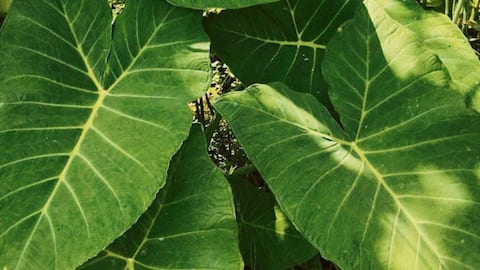How to care for elephant ear plants
What's the story
Elephant ear or colocasia, a tropical plant, has extravagant leaves and thrives in moist environments. Its unique trait is signaling the need for watering through drooping stalks. These stalks, resembling straws filled with water, support the large leaves. Insufficient water causes the leaves to become heavy, leading to yellowing. Regular watering revitalizes the plant; consistently damp soil is essential for its optimal health.
Sunlight
Partial shade
Elephant ears thrive in various light conditions, from full sun to partial shade, yet they prefer environments with partial or filtered shade. Varieties with darker leaves require increased sunlight to retain their coloration. Notably, increased sun exposure corresponds to heightened water needs for elephant ears. Therefore, the amount of water required corresponds directly to the level of sunlight provided to the plants.
Soil
Moist soil
Cultivate elephant ears in fertile, loamy soil with a slight acidity. Since they are wetland plants, they thrive well in boggy, marshland areas and water gardens, as they require plenty of water. Preparing the soil adequately before planting may entail incorporating compost to attain optimal soil conditions. Mix in enough organic matter such as chopped leaves and peat to form a balanced compost.
Watering
Consistent moisture
Maintain consistent moisture levels for the plants by ensuring the soil remains consistently damp. Though they exhibit remarkable resilience, capable of surviving in up to six inches of standing water, optimal indoor growth occurs when the soil is consistently wet and not waterlogged. Avoid allowing the soil to completely dry out, as this can adversely affect the plant's health and vigor.
Fertilizer
Frequent feeding
Elephant ears, like many large-leaved tropical species, demands frequent feeding. Apply water-soluble, high-nitrogen fertilizer every two to three weeks for optimal growth. Yellowing foliage signals potential micronutrient deficiency, requiring fertilizers with micronutrients or periodic epsom salt applications. Avoid fertilizing during dormancy, especially in winter. Indoor plants benefit from spring and summer fertilization with houseplant-specific products, discontinuing during fall and winter.
Planting tips
Potting elephant ears
When planting elephant ears, bury them approximately four inches deep. In caring for container plants, it is crucial to note they demand increased watering compared to their in-ground counterparts. Particularly in warm weather, watering them twice daily is essential. Select adequately sized pots proportional to the plant's large leaves, with ample holes for adequate moisture retention, proper drainage and soil aeration.
Caution
Signs to watch
Elephant ears exhibit drooping leaves when facing imbalances in light, water, or fertilizer levels. Cold temperatures can also lead to plant decline. Deformed, smaller, or pale leaves indicate deficiencies in nutrients, light, or water. Yellowing leaves signal the need for adjustments in sunlight, water, or fertilizer levels. Additionally, their affinity for water makes them susceptible to fungal infections.
